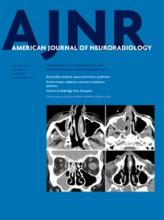Abstract
BACKGROUND AND PURPOSE: Global cerebral edema is an independent predictor of mortality and poor outcomes after aneurysmal SAH. Global cerebral edema, a complex disease process, is thought to be associated with an altered cerebral autoregulatory response. We studied the association between cerebral hemodynamics and early global cerebral edema by using CTP.
MATERIALS AND METHODS: We retrospectively studied consecutive patients with aneurysmal SAH with admission CTP performed at days 0–3. Two neuroradiologists classified global cerebral edema and hydrocephalus on NCCT performed concurrently with CTP. Global cerebral edema was defined as diffuse effacement of the sulci and/or basal cisterns or diffuse disruption of the cerebral gray-white matter junction. CTP was postprocessed into CBF and MTT maps by using a standardized method. Quantitative analysis of CTP was performed by using standard protocol with ROI sampling of the cerebral cortex. The Fisher exact test, Mann-Whitney test, and independent-samples t test were used to determine statistical associations.
RESULTS: Of the 45 patients included, 42% (19/45) had global cerebral edema and 58% (26/45) did not. Patient groups with and without global cerebral edema were well-matched for demographic and clinical data. Patients with global cerebral edema were more likely to have qualitative global CTP deficits than those without global cerebral edema (P = .001) with an OR = 13.3 (95% CI, 2.09–138.63). Patients with global cerebral edema also had a very strong trend toward statistical significance, with reduced quantitative CBF compared with patients without global cerebral edema (P = .064).
CONCLUSIONS: Global perfusion deficits are significantly associated with global cerebral edema in the early phase after aneurysmal SAH, supporting the theory that hemodynamic disturbances occur in global cerebral edema.
ABBREVIATIONS:
- GCE
- global cerebral edema
- aSAH
- aneurysmal subarachnoid hemorrhage
- DCI
- delayed cerebral ischemia
- © 2015 by American Journal of Neuroradiology
Indicates open access to non-subscribers at www.ajnr.org












